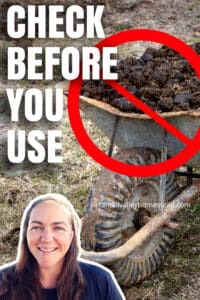Aminopyralid or persistent broadleaf herbicide residue in contaminated manure or compost is becoming a really big issue for gardeners, and SOMEHOW I have managed to contaminate my new tunnel house. Thankfully I have an action plan on what you can do to fix contaminated garden soil at your place.
Which Herbicides Contaminate Manure, Compost, and Soil?
Certain herbicides, known for killing weeds, often cause problems when they contaminate commercial manure, compost, and soil. These include:
Please read: This information is provided for educational purposes only and is not intended to treat, diagnose or prevent any disease. We encourage you to make your own health care decisions in partnership with a qualified health care professional.
This post contains affiliate links, this means at no extra cost to you, we make a commission from sales. Please read
our Disclosure Statement
– Aminocyclopyrachlor
– Aminopyralid
– Clopyralid
– Picloram
– Fluroxypyr
– Triclopyr
These herbicides are part of a group called synthetic auxin herbicides. They mimic a natural plant hormone called auxin and disrupt the growth of sensitive broadleaf plants, but they don’t affect most grasses.
Even older versions of these herbicides have been causing problems for decades. The newer versions are much stronger and stay in the environment longer, increasing contamination risks significantly.
These herbicides are used on various crops, pastures, and non-crop areas like commercial lawns and forests. They are even applied near water sources to control weeds. Despite their approval by regulatory agencies, which consider them low-risk for livestock, problems arise when these herbicides persist in manure and compost.
How These Herbicides Contaminate Manure, Compost, and Soil
Synthetic auxin herbicides attach to lignin, a compound in plant cell walls. When animals eat grass treated with these herbicides, they pass through the digestive system unchanged and are excreted in manure. These herbicides then remain in the manure and can contaminate compost and soil.
They are highly mobile and can move with water, potentially reaching groundwater and affecting non-target plants. They can stay active in soil, compost, and manure for a long time, breaking down very slowly. This breakdown can take from a month to several years, depending on conditions.
Some herbicides, like fluroxypyr and triclopyr, are less persistent but can still cause damage.
Which Plants Are Sensitive to These Herbicides?
Not all plants are affected by synthetic auxin herbicides, but many edible and ornamental plants are. Sensitive plants include:
Legumes: peas, beans, lentils, clover
Nightshades: tomatoes, eggplant, peppers, potatoes, tobacco
Cucurbits: cucumber, squash, pumpkin, watermelon
Apiaceae (carrot family): angelica, anise, chervil, coriander, cumin, dill, fennel, carrots, celery, parsnips, parsley
Daisies: sunflowers, petunias, daisies, asters, lettuce
Ornamental flowers: dahlias, marigolds, some roses
Symptoms of persistent herbicides in plants
In this video I show you how my plants look:
For more information on treating contaminated soil successfully, read here.
Doing a bioassay to check for contaminated soil
If you’re unsure whether your compost contains herbicides, it’s a good idea to run a simple and affordable test, called a bioassay, before using it in your garden. This test can detect herbicides that might harm your plants, even if they’re present in very small amounts. Keep in mind that the test takes about three to four weeks to complete.
Steps for a Bioassay:
- Collect Samples: Take small shovelfuls of your suspect compost or manure from different spots in the pile, making sure to dig deep. Mix them thoroughly. If some parts are dry and others are moist, test them separately since dry areas may have more herbicide.
- Prepare Pots: Get three to six small pots (4 to 5 inches in size). Fill some with a 50/50 mix of your compost and commercial potting soil. Fill at least one pot with only the commercial potting soil, without any compost to be the control.
- Label Pots: Clearly label the pots so you know which ones contain compost or manure and if you are testing several samples, mark which is which.
- Position the Pots: Place saucers under each pot or space them far enough apart so water doesn’t drain from one pot to another as this can mess up the results.
- Plant Seeds: In each pot, plant three-4 pea or bean seeds. Water them as usual and let them grow for two to three weeks.
- Observe the Plants: After two to three weeks, your plants should have at least three sets of true leaves. Look for signs of abnormal growth, such as poor seed germination, twisted or curled leaves, dying plants or failure to break the surface/germinate.
If the plants in the compost or manure show these problems, but the plants in the plain potting soil look healthy, then your compost/manure is likely contaminated with herbicides.
For visual instructions on doing a bio assay to check the soil for contamination, watch this video:


